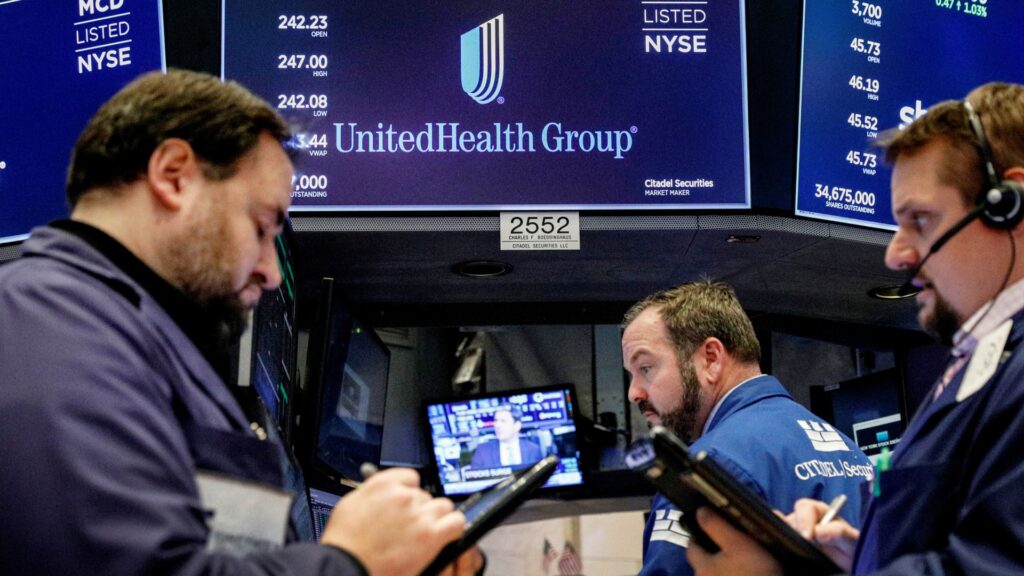
Medicare Advantage Medical Costs Force UnitedHealth to Slash Profit Forecast
Medicare Advantage Medical Costs Force UnitedHealth to Slash Profit Forecast
Published on April 18, 2025
UnitedHealth Group headquarters in Minnetonka, Minnesota. The company’s shares plunged 20% after cutting its annual profit forecast due to rising Medicare Advantage medical costs. (Image: Representative)
Table of Contents
The healthcare insurance industry faced a significant shock on Thursday as UnitedHealth Group’s stock sank 20% following the company’s announcement that it was slashing its annual profit forecast due to higher-than-expected Medicare Advantage medical costs. This dramatic development has sent ripples throughout the insurance sector, potentially signaling broader challenges for companies offering Medicare Advantage plans to seniors across the United States. The unexpected surge in medical costs within these privately run Medicare plans has raised concerns about the financial health of the entire healthcare insurance industry in the coming quarters.
UnitedHealth’s 20% Stock Plunge
UnitedHealth Group, widely regarded as the insurance industry’s bellwether, stunned investors with its revised profit outlook, citing significantly higher Medicare Advantage medical costs than previously anticipated. This announcement triggered the company’s worst single-day stock performance in years, erasing billions in market value. The drastic cut to profit guidance comes after a particularly challenging period for the insurance giant, which has been dealing with multiple headwinds throughout 2024 and into 2025.
The company’s revised forecast reflects a troubling trend in its Medicare Advantage business, where healthcare utilization rates have significantly exceeded projections. This comes at a particularly challenging time for UnitedHealth, which is still recovering from the tragic murder of UnitedHealthcare’s top executive, Brian Thompson, and is reportedly facing a government investigation into its Medicare billing practices. These compounding issues have created a perfect storm for the healthcare giant, whose performance is closely monitored as an indicator for the broader industry.

Medicare Advantage enrollment has grown significantly in recent years, with approximately 32 million seniors now covered by these plans. (Image: Representative)
Industry-Wide Impact of Rising Medical Costs
The revelation of escalating Medicare Advantage medical costs at UnitedHealth quickly triggered a sell-off across other major health insurers with exposure to this market segment. Humana, which has significant Medicare Advantage market share, saw its stock fall 5% in the wake of UnitedHealth’s announcement. Elevance Health dropped more than 1%, while CVS Health, which offers Medicare Advantage plans through its Aetna subsidiary, tumbled 2%. Only Cigna, which has no Medicare Advantage business, managed to buck the trend with a modest gain of nearly 1%.
Stock Performance Following UnitedHealth’s Announcement
- UnitedHealth Group: -20.0%
- Humana: -5.0%
- Elevance Health: -1.3%
- CVS Health: -2.0%
- Cigna: +0.9% (No Medicare Advantage business)
- Alignment Health: Market reaction pending (Significant Medicare Advantage exposure)
TD Cowen analyst Ryan Langston described UnitedHealth’s first-quarter results as revealing “ominous signs” of accelerating medical costs in Medicare Advantage businesses. His note pointed out that UnitedHealth had “correctly foreshadowed” increasing medical costs back in 2023, suggesting that Thursday’s comments “will call into question” the full-year outlooks for every insurer in the space. The mounting evidence of an industry-wide issue has heightened investor concerns about the sustainability of current business models in the Medicare Advantage sector.
“It’s very, very unusual. [Rising utilization is] really surprising coming off the high level of care activity that the industry saw over the past year.”
Unprecedented Surge in Healthcare Utilization
At the heart of the issue driving up Medicare Advantage medical costs is an unexpected surge in healthcare utilization among seniors enrolled in these plans. According to UnitedHealth Group CEO Andrew Witty, the rise in care use in its Medicare Advantage business significantly exceeded what the company had planned for the year. Most concerning was that trends becoming apparent toward the end of the first quarter suggest that care activity increased “at twice” the level the company had anticipated, a deviation that substantially impacts profitability.
Key Factors Driving Medicare Advantage Medical Costs
- Post-Pandemic Catch-Up Care: Seniors returning to hospitals for previously delayed procedures
- Outpatient Service Utilization: Particularly high increase in doctor visits and day procedures
- Population Health Factors: Aging demographics and increasing chronic condition prevalence
- Relaxed Utilization Management: Potential reduction in prior authorization requirements
- Regulatory Scrutiny: Possible changes in response to government investigations
The higher medical costs have affected the entire insurance industry over the past year as more seniors return to hospitals to undergo procedures they had delayed during the COVID-19 pandemic, such as joint and hip replacements. However, until now, this issue had not been as significant at UnitedHealthcare as at some of its competitors, making Thursday’s announcement particularly unexpected and concerning for industry watchers.
Outpatient Services Driving Cost Increases
A particularly noteworthy aspect of the rising Medicare Advantage medical costs identified by UnitedHealth was the concentration of increased utilization in doctor and outpatient services that do not involve overnight hospital stays. This pattern suggests a shift in how and where Medicare Advantage members are seeking care, potentially reflecting changing preferences post-pandemic or evolving approaches to managing certain health conditions.
Inpatient Services
- Hospital stays
- Surgical procedures requiring admission
- Intensive care treatment
- Post-surgical recovery
- More predictable utilization patterns
Outpatient Services
- Physician office visits
- Diagnostic testing and imaging
- Same-day surgeries
- Specialist consultations
- Showing unexpectedly high utilization
The surge in outpatient care utilization presents unique challenges for insurers managing Medicare Advantage medical costs. While these services are typically less expensive on a per-visit basis than inpatient care, their higher frequency and volume can collectively drive significant cost increases. Additionally, outpatient services can be more difficult to manage through traditional utilization review processes, potentially contributing to the unexpected cost acceleration.
How Market Positioning Affects Different Insurers
Not all health insurers will be equally impacted by the rising Medicare Advantage medical costs, according to industry analysts. Barclays analyst Andrew Mok suggested that UnitedHealth’s problems may be less of an issue for companies that made “significant” exits from some Medicare Advantage markets in the previous year, including Humana and CVS. Many insurers proactively exited unprofitable Medicare Advantage markets due to higher medical costs and lower reimbursement rates from the federal government, a strategic decision that may now prove beneficial.
Medicare Advantage Market Exposure Analysis
How different insurers’ strategic positioning may affect their vulnerability to rising Medicare Advantage medical costs:
- Greater Risk: Companies that gained market share (Elevance Health, Alignment Health)
- Moderate Risk: Companies maintaining stable market share (UnitedHealth)
- Lower Risk: Companies that exited unprofitable markets (Humana, CVS/Aetna)
- Minimal Risk: Companies with no Medicare Advantage exposure (Cigna)
- Regional Variables: Market-specific factors may create varying impact patterns
Conversely, Mok indicated that the issue could be a bigger concern for companies that gained greater market share in Medicare Advantage during recent enrollment periods, such as Elevance Health and Alignment Health. This assessment suggests that recent strategic decisions regarding Medicare Advantage market participation may significantly influence how different insurers weather the current surge in medical costs.
Changes in Utilization Management Practices
Another factor potentially contributing to the spike in Medicare Advantage medical costs could be changes in how insurers are managing utilization. Bernstein analyst Lance Wilkes suggested that UnitedHealth and possibly other insurers may be “pulling back” the “intensity of some of the activity they do to manage utilization,” which typically causes dissatisfaction among patients. One example of such management practices is prior authorization, which requires providers to obtain approval from a patient’s insurance company before administering specific treatments.

Prior authorization practices and other utilization management techniques have been under increased scrutiny from regulators and patients. (Image: Representative)
“I think it’s probably United pulling back because of the policy headwinds and the scrutiny on the company. I do think the horrible thing that happened to Brian Thompson and the company is a part of this, and I think it’s reflective of also the Department of Justice scrutiny on United over the last couple years.”
This perspective suggests that external pressures, including regulatory scrutiny and public sentiment, may be influencing operational decisions that indirectly impact Medicare Advantage medical costs. The regulatory environment for Medicare Advantage has become increasingly complex, with insurers facing greater oversight of their management practices alongside requirements to maintain high quality ratings and member satisfaction scores.
Future Outlook and Potential Relief
Despite the immediate concerns about rising Medicare Advantage medical costs, there are some potential bright spots on the horizon for insurers. UnitedHealth CEO Andrew Witty expressed confidence that the issues related to both the company’s Optum health-care unit and elevated medical costs are “highly addressable as we look ahead to 2026.” This suggests that the company sees the current challenges as manageable with appropriate strategic adjustments.
Factors That May Alleviate Medicare Advantage Cost Pressures
- Higher Reimbursement Rates: Trump administration’s planned increase in Medicare Advantage payments
- Enhanced Cost Management: New approaches to utilization management
- Premium Adjustments: Potential for higher premiums in future enrollment periods
- Benefit Restructuring: Possible modifications to plan designs and coverage terms
- Market Rationalization: Continued strategic exits from unprofitable markets
A significant development that could help offset rising Medicare Advantage medical costs is the Trump administration’s recent announcement that it would substantially increase reimbursement rates for Medicare Advantage insurers, hiking an earlier proposal from the Biden administration. This policy change represents a potential financial boost for insurers struggling with higher medical costs, though its full impact won’t be felt until 2026.
The healthcare insurance industry is now closely watching for the next earnings reports from other major insurers with Medicare Advantage exposure. These upcoming financial disclosures will help clarify whether UnitedHealth’s experience with escalating Medicare Advantage medical costs reflects a company-specific issue or, as many analysts suspect, signals a broader trend affecting the entire sector. The answers will have significant implications for the millions of seniors enrolled in these plans, as well as for the future structure and sustainability of the Medicare Advantage program itself.
Published on April 18, 2025 | Updated on April 18, 2025






